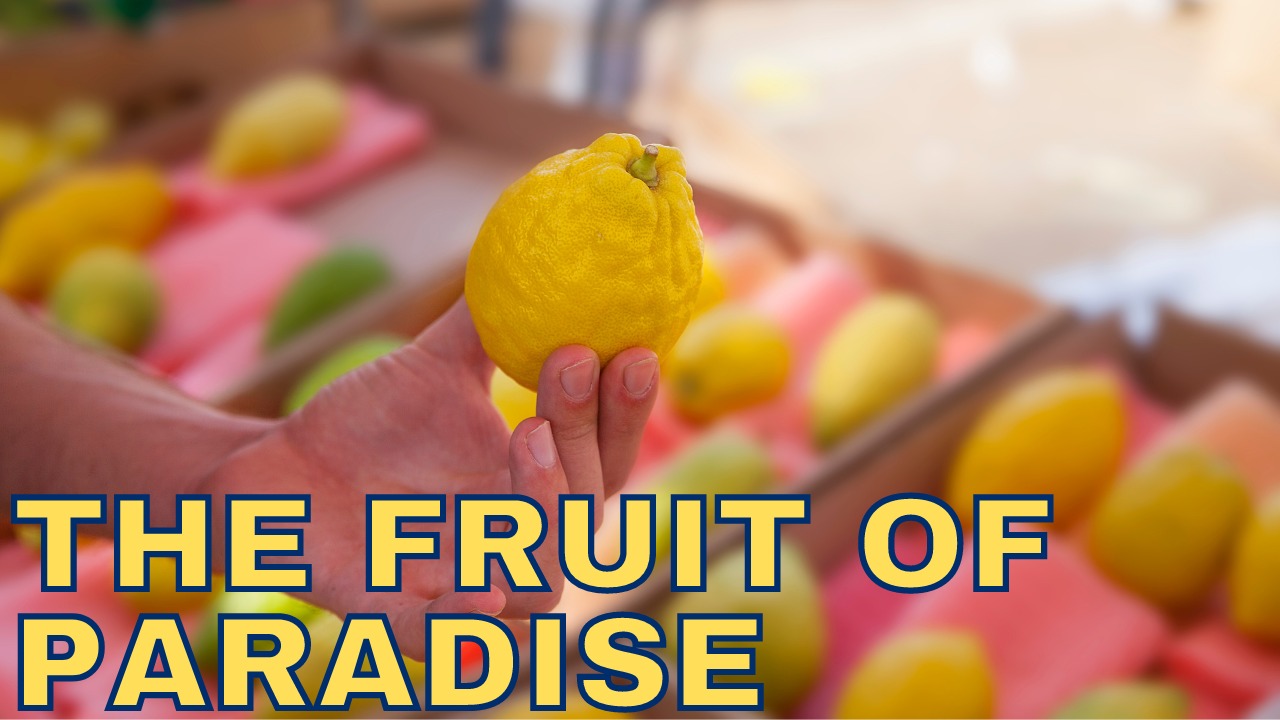THE FRUIT OF PARADISE

(For the SoundCloud audio, scroll down)
In what has become a cherished annual tradition, each year I visit our local Arba Minim supplier to personally procure a set of Arba Minim to use each day of Sukkot. An Arba Minim set is made up of four species of plants—lulav (palm frond), hadass (myrtle), aravah (willow), and etrog (citron)—and is used in a daily religious ritual during the festival of Sukkot, except on Shabbat.
Nowadays, with modern agricultural techniques and the ease of global shipping, obtaining a set is as easy as visiting your local pop-up Arba Minim vendor, browsing through the stock, and paying the somewhat inflated but not totally outrageous price. But it wasn’t always so.
During the Middle Ages and even into the modern era, as Jewish communities sprouted in Northern Europe and later on, in Eastern Europe, obtaining Arba Minim, and particularly the etrog, became a major ordeal. Shipping methods were rudimentary, and long-distance travel was fraught with dangers and hurdles. Towns with hundreds of Jewish families were often only able to obtain a handful of sets at best, and occasionally there were none.
And, unsurprisingly, prices were prohibitive. None of the four species has significant retail value, aside from during this fevered period of demand by Jewish communities across the globe. Only one of them – myrtle – is broadly used for non-Arba Minim-related purposes: as a favorite of landscape gardeners, or as an ingredient for fragrant oil production and traditional medicines, and, in Corsica and Sardinia, as the base for Mirto liqueur, a popular local libation.
Historically, Arba Minim monopolies often became a source of grinding community friction. In the late seventeenth century, a particularly notorious battle over the right to sell etrogs in Frankfurt took a nasty turn. The Frankfurt agricultural fair was a lucrative regional center for the Arba Minim business, both wholesale and retail.
One etrog dealer, Calmann Trucker from Hanau, held the exclusive right to sell etrogs in Frankfurt, but was summarily banned from selling them by local community leaders in the summer of 1684 – and they also wrote to other communities to ensure he couldn’t relocate and set up shop elsewhere.
Trucker’s father was also barred from selling etrogs, whereupon Trucker decided to involve the local gentile authorities. But it was to no avail, and his attempt to thwart the Frankfurt Jewish community leadership via the gentile powers-that-be ultimately failed.
Whatever it was that Trucker had done to annoy the Jewish leaders put him out of business for good, and the Frankfurt Arba Minim trade was temporarily granted to a local Jew called Herz Buchsboim. Within a couple of years, another etrog dealer had moved permanently to Frankfurt with his family, and that was that.
Unscrupulous practices by etrog dealers were the stuff of legends. In 1630, a certain Asher from Reichshofen—a small town in France’s Rhineland—learned that no etrogs would be available locally for Sukkot. Despite searching far and wide, he was unable to find one, and consequently, he prepared himself for the festival without this essential component of the Arba Minim.
But just days before the festival, a Jewish traveler arrived at the synagogue with two small etrogs for sale. Without a local rabbi and lacking time to seek expertise elsewhere, Asher turned to his own collection of rabbinic texts and deemed the etrogs kosher. He purchased them at an exorbitant price, thereby enabling the entire community to celebrate Sukkot with a complete Arba Minim set. However, after the festival, he cut open the two fruits and was dismayed to discover that they were in fact lemons, not etrogs.
Etrog growers were equally deceitful. Grafting techniques were widely used to combine lemon trees with etrog trees, resulting in smoother, cleaner fruit. Most rabbinic authorities insisted that such etrogs could not be used for Arba Minim. Nevertheless, Rabbi Moshe Isserles of Cracow (“Rema”; 1530-1572) – the venerated source of Ashkenazic custom – was hesitant to ban grafted etrogs outright, as he knew that many people used them when there was nothing else available (Shu”t ha-Rema, no. 117).
What I find most fascinating about the etrog is that unlike almost every other animal or plant mentioned in the Torah, it does not originate in the Middle East. Modern science has established that the earliest etrogs came from the Yunnan Province, a large region in Southwest China bordering Vietnam, Laos, and Myanmar.
The etrog then moved westward into India, where it was used as a decorative fruit, and then, with the Persian conquest of India, it eventually traveled to the Middle East and the Mediterranean, along with all citrus fruits now considered native to that area.
The first etrogs grown in Eretz Yisrael were cultivated by Persians during the period of the Babylonian Exile after the destruction of the first Jerusalem Temple. The Persian administrative center for Yehud – as Israel was known – was where Ramat Rachel is today, just south of the site of ancient Jerusalem.
Alongside the administrative center was an annex that included an area they called a pairidaeza – a cultivated garden area whose name is the etymological source for the English word paradise. In 2013, a team of archaeologists from Tel Aviv University analyzed fossilized pollen from the Ramat Rachel pairidaeza and published their findings.
The data showed that alongside pollen from well-established local plants, such as figs, grapes, olives, myrtle, and willow, was the pollen of the etrog tree – 4,000 miles from its origins in the valleys of Yunnan.
Reflecting on this history, I find myself standing at my local Los Angeles Arba Minim vendor, meticulously examining each etrog and lulav before making my selection. The weight of generations of challenges and tales of determination in securing these religious artifacts is palpable.
As I choose my set, I’m overwhelmed with gratitude for the ease with which we can now acquire these unique and sacred plant species. Sukkot, heralded by the Talmud as z’man simhateinu – “a time of our joy,” is made all the more joyous by recognizing our modern-day fortune. In an era where procuring Arba Minim is so simple, we should all be reminded to cherish the comforts we enjoy and remember the tenacity of our ancestors.
(With special thanks to Sharon Liberman Mintz, who gifted me the book: Klein/Liberman Mintz/Teplitsky, Be Fruitful! The Etrog in Jewish Art, Culture, and History, Mineged Publishing, Jerusalem/New York, 2022 — from which I derived much of the information in this article.)

